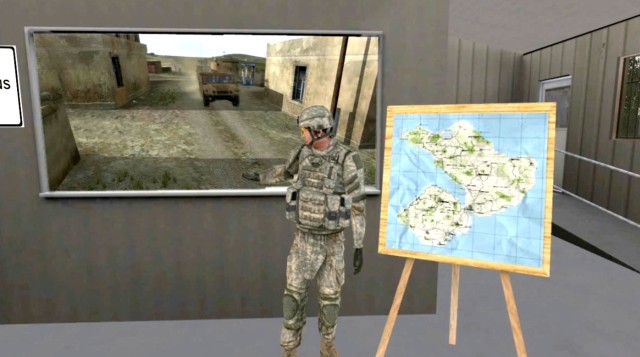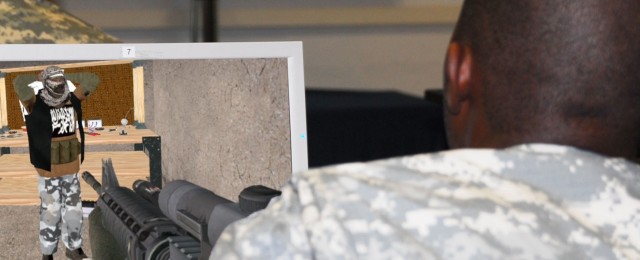FORT HUACHUCA, Ariz. -- Soldiers on Fort Huachuca now have the opportunity to train with cutting-edge technology.
The Learning Technology Directorate's Game Team recently released Military Intelligence Game, Version 3. The computerized game replaces hours of PowerPoint and slide shows with hands-on interactive learning.
MI Game, v3 was initially developed as a capabilities demonstration and was later requested for the 35F course on Fort Huachuca. The interactive game takes a team effort; it requires five Soldiers to play. The roles include Human Intelligence, Signal Intelligence, Unmanned Aerial System, S2, and Tactical Site Exploitation.
"It's a team collaborative exercise of game if you will," explained James Andersen, MI Gaming executive producer. "The S2 person essentially controls everything within the game as far as where people should go, what they should be looking for and asking questions; that type of thing."
Andersen added that although MI Game, v3 presently has five positions, the game can be customized to meet the needs of other training courses.
The S2 player and assistant S2 usually get the most out of the game, in the sense they understand how complicated it is to manage various collections assets said Andersen.
"MI Game, v3 forces collaboration between intelligence platforms," stated Tony Garcia, MI game developer.
It forces each of the players to cooperate and coordinate with each other or else they won't get the full picture, so it is essentially a problem-solving exercise, he explained.
The job of Learning Technology Directorate personnel here is to take a particular course's training requirement and create a more effective learning environment. The department uses technology to improve the learning environment retention, said Andersen.
The department created MI Game, v3 from the game Virtual Battle Space 2.
"That's what the Army uses as their first attempt at bringing a game engine into a training environment," Andersen said. MI Game, v3 is a modification to the actual VBS2.
"What we've done is taken a first-person shooter, what VBS2 is, and we have taken out the first person shooter aspect and put a military spin on it so that you're working as an analyst in various ways," added Andersen.
Soldiers who are not Intelligence will get a better understanding of how the Intel cycle works, he noted.
"Whether the participants are from military backgrounds or not, they all agree that MI Game, v3 is a great exposure to the MI world without being inundated with too much information," explained Garcia.
The game is set up for 90 minutes of play, but can be played shorter or longer depending on the instructor and team.
"If after 15 minutes, the students are in a general consensus that they have all the answers, the game can be stopped," said Andersen.
There are currently 30 laptops equipped with MI Game, v3 in Davis Hall, room 149 that the 35F course is using to train. Andersen said the room is scheduled by the G3.
Common Access Card holders may access MI Game, v3 and the Learning Technology's training videos at https://milgaming.army.mil.
Students must use a VBS2 machine to play MI Game, v3 which includes VBS2 scenarios.
For more information on MI Game, v3, contact Edwin Morris, project manager, 533-7140 or Edwin.morris@us.army.mil, or James Andersen, 227-7625 or james.andersen@us.army.mil.




Social Sharing